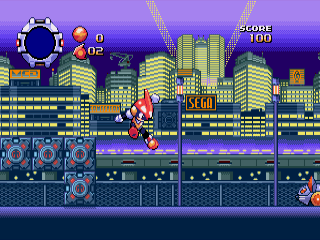Game Freak is most commonly associated with the Pokemon series, but it’s certainly not a young company. In fact, it began releasing games for non-Nintendo consoles as early as the 1990s. One such title is the Japanese import, Pulseman, for the Sega Genesis. Thanks to the Virtual Console, we can witness the group’s more humble work.
 The level design is ho-hum as a whole, neither impressive nor poor. The real interesting thing is Pulseman himself. He’s a rather agile fellow and can perform mid-air kicks that render him temporarily invincible. With an electric charge, he can temporarily transform into a diagonal-bound ball, allowing him to reach new areas. Moreover, he can ricochet off walls to increase his time in ball form. The danger of running and dashing to gain a charge is that you might run into an enemy, which probably isn’t worth the risk. There’s a subtle bit of strategy in planning when you’ll tap into your powers and when to fight as a human.
The level design is ho-hum as a whole, neither impressive nor poor. The real interesting thing is Pulseman himself. He’s a rather agile fellow and can perform mid-air kicks that render him temporarily invincible. With an electric charge, he can temporarily transform into a diagonal-bound ball, allowing him to reach new areas. Moreover, he can ricochet off walls to increase his time in ball form. The danger of running and dashing to gain a charge is that you might run into an enemy, which probably isn’t worth the risk. There’s a subtle bit of strategy in planning when you’ll tap into your powers and when to fight as a human. Aside from the intriguing mechanics in the control scheme, the most noteworthy aspect is the visual presentation. When Pulseman is exploring regular real-world locations like Japan and Australia, the graphics are rather tame and mundane. That’s not to downplay the experience though, for the sprite work is utterly sublime (especially on the Sega Genesis). When he taps into the virtual world, things get a lot trippier. Delirious effects overflow in the virtual world such as 3D scrolling background trees and erratic flashing colours. I’m not joking when I say seizures may be induced. The level of background insanity can become distracting at times, and those with a history of eye problems should stay far away. With that said, the graphics certainly succeed in differentiating the two worlds. You’ll never confuse the two.
Aside from the intriguing mechanics in the control scheme, the most noteworthy aspect is the visual presentation. When Pulseman is exploring regular real-world locations like Japan and Australia, the graphics are rather tame and mundane. That’s not to downplay the experience though, for the sprite work is utterly sublime (especially on the Sega Genesis). When he taps into the virtual world, things get a lot trippier. Delirious effects overflow in the virtual world such as 3D scrolling background trees and erratic flashing colours. I’m not joking when I say seizures may be induced. The level of background insanity can become distracting at times, and those with a history of eye problems should stay far away. With that said, the graphics certainly succeed in differentiating the two worlds. You’ll never confuse the two. 








I was interested in acquiring this game via the Virtual Console service, but my Wii is out of service. I sent it to get repaired yesterday. I love 2D side-scrollers!